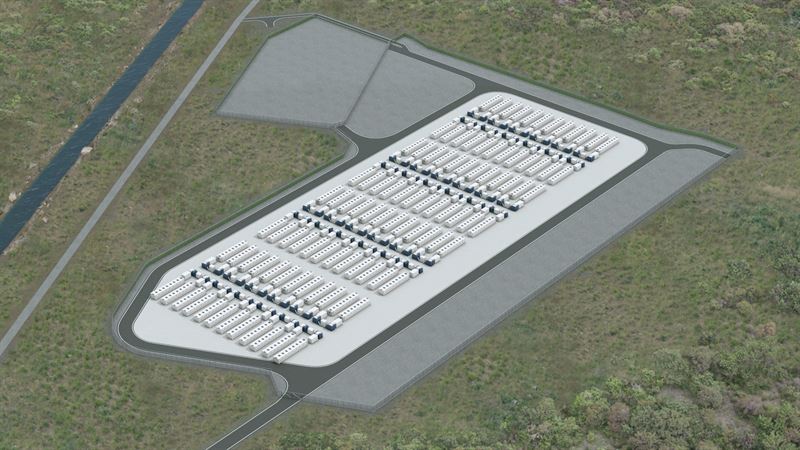As the U.S. embraces an all-of-the-above energy strategy, balancing energy security with needs to lower emissions and meet demand, battery storage has become a crucial grid balancer.
The energy storage investment tax credit provided in the Inflation Reduction Act (IRA) is giving it strength, luring investors to projects focused on storing excess energy when the wind doesn’t blow and the sun doesn’t shine.
“Battery storage is really one of the key ways of addressing that intermittency,” David Burton, partner at Norton Rose Fulbright U.S., told Hart Energy. “As fossil-fired plants age, it provides backup contingency power if a fossil plant goes down due to needing maintenance or having other issues. It’s also useful as we have weather events to smooth out the production levels during that.”

Burton is one of the attorneys who advised Eolian LP, a portfolio company of investment fund Global Infrastructure Partners that closed a tax equity investment in two standalone utility-scale battery storage projects in Texas. Eolian said the deal, made public in February, marked the first time the investment tax credit (ITC) for a stand-alone utility-scale battery energy storage system was used since the IRA took effect in January 2023.
“If someone’s willing to give you a 30% tax credit, of course you want that,” Burton said. “A 30% minimum tax credit is pretty attractive.”
‘New face of grid resilience’
With a combined operating capacity of 200 megawatts (MW), the Madero and Ignacio projects are interconnected battery storage facilities located on one site in Mission, Texas, in a part of the Deep South’s Rio Grande Valley bordering Mexico. Scheduled to begin full commercial operations this year, Eolian said the facilities would become part of the liquid energy market managed by the Electric Reliability Council of Texas, having been “engineered with multiple hours of operational duration to provide critical grid resiliency.”
The tax equity investment, used by investors to fund projects for the right to claim that investment’s tax credits, was made by Florida-based Churchill Statewide Group. The group is comprised of real estate financial services companies.
“This energy storage project is the largest of its kind in the world, represents hundreds of millions of dollars in direct investment by private investors and solves the problem of meeting demand during hours of high uncertainty that require highly dynamic units that can turn on remotely and instantaneously to keep the lights on,” Eolian CEO Aaron Zubaty said in a news release. “The new face of grid resilience is fast and flexible energy storage to fill the gaps when other resources are too slow or too fragile to meet the challenge.”
A March 2023 report by Wood Mackenzie Power & Renewables/American Clean Power Association showed the U.S. storage market added 1,067 MW/3,030 MWh across all segments in fourth-quarter 2022, marking the fifth highest overall quarter on record in MW-terms amid supply chain challenges.
“Between 2023 and 2027, the U.S. storage market will install almost 75 GW [gigawatts], with grid-scale installations accounting for 81% of total capacity,” the report stated.
With 30% tax credits through 2032, the ITC for stand-alone energy storage assets in the IRA is incentivizing investment. The law made energy storage systems with at least a 5 kilowatt-hour (kWh) capacity eligible, including stand-alone systems, those co-located with solar and microgrid controllers.
Provisions also include prevailing wage and apprenticeship requirements, with an exemption for smaller projects, plus direct-pay.
‘A more certain path’
Prior to the IRA’s passage, the ITC didn’t apply to energy storage projects.
“If you didn’t have a large tax liability [to] offset the tax credits, then tax equity was really your only alternative. And it allowed you to capture much of the value of the tax credits and the depreciation, even though you couldn't use them yourselves,” Burton said. “The IRA gave us transferability whereby tax credits can literally be sold pursuant to a bill of sale without doing a complicated tax equity financing transaction.”
Transferability would have been an alternative for Eolian. However, the tax equity was not only more lucrative financially and could be monetized, it could also raise cash sooner than waiting for year-end to transfer the credits the following year, Burton said. “So, it was a more certain path then the transferability tax credits set of rules that the IRA gave us,” he said.
Pursuing the new ITC for the energy storage project was no different than any other investment tax credit-tax equity transaction, according to Burton.
“Generally, it follows a similar pattern as other ITC tax-free transactions, but we had to get comfortable with the IRA and [determine] whether the project qualified,” he said “Then, it was a matter of approaching the tax equity market.”
When looking to pursue the ITC, Burton said a net should be cast wide when seeking tax equity investors, and conversations should take place early and often to gauge interest and comfort with the project.

‘Great time for energy storage’
Some tax equity investors may have a learning curve when it comes to the different nature of revenue streams for standalone battery storage projects, said Marissa Alcala, co-partner-in-charge for Norton Rose Fulbright. In some locations, owners of storage facility co-located with wind or solar projects can earn revenue via different types of contracts. Such revenue streams could be for ancillary or grid-balancing services.

The ITC is expected to help expand the energy storage market. However, other mechanisms could provide a boost.
Domestic manufacturing of infrastructure equipment could be a positive in reducing some of the supply chain challenges, Alcala said. That could open the door to additional incentives.
Improvements to transmission lines and the permitting and approval process from various jurisdictions would also help, Burton added.
“This is actually a great time for the energy storage market,” Alcala said.
With the growth of renewables, activity and interest in the energy storage market are growing.
“It’s become increasingly important for effective regulation and operation of the grid, as well as an increasingly useful tool for companies who are trying to use or include renewable energy to be able to store and then utilize during off hours,” said Alcala. “When you combine the two components … battery storage is going to be an increasingly important component of the energy sector.”
Recommended Reading
TotalEnergies Starts Production at Akpo West Offshore Nigeria
2024-02-07 - Subsea tieback expected to add 14,000 bbl/d of condensate by mid-year, and up to 4 MMcm/d of gas by 2028.
Seadrill Awarded $97.5 Million in Drillship Contracts
2024-01-30 - Seadrill will also resume management services for its West Auriga drillship earlier than anticipated.
Remotely Controlled Well Completion Carried Out at SNEPCo’s Bonga Field
2024-02-27 - Optime Subsea, which supplied the operation’s remotely operated controls system, says its technology reduces equipment from transportation lists and reduces operation time.
Shell Brings Deepwater Rydberg Subsea Tieback Onstream
2024-02-23 - The two-well Gulf of Mexico development will send 16,000 boe/d at peak rates to the Appomattox production semisubmersible.
Less Heisenberg Uncertainty with Appraisal Wells
2024-03-21 - Equinor proves Heisenberg in the North Sea holds 25 MMboe to 56 MMboe, and studies are underway for a potential fast-track tieback development.






